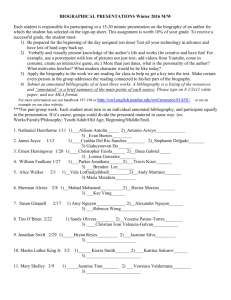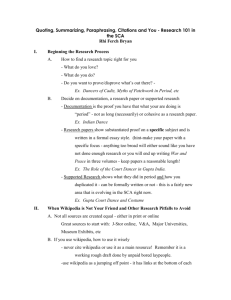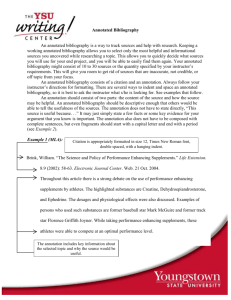Annotated Bibliography - University Writing Center
advertisement
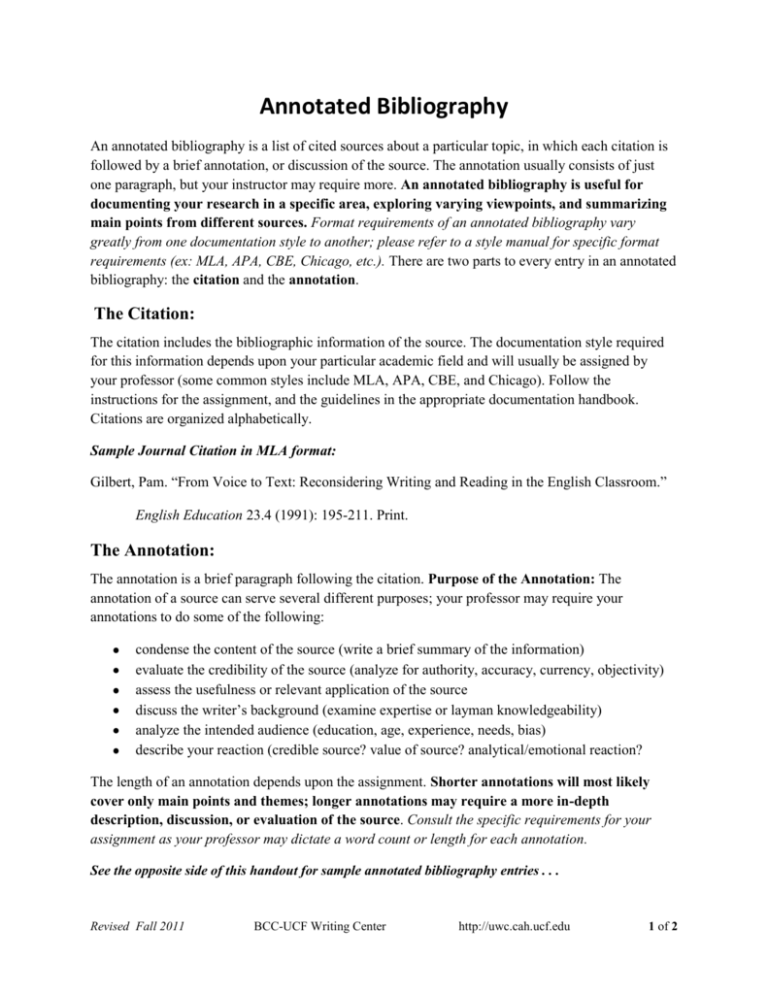
Annotated Bibliography An annotated bibliography is a list of cited sources about a particular topic, in which each citation is followed by a brief annotation, or discussion of the source. The annotation usually consists of just one paragraph, but your instructor may require more. An annotated bibliography is useful for documenting your research in a specific area, exploring varying viewpoints, and summarizing main points from different sources. Format requirements of an annotated bibliography vary greatly from one documentation style to another; please refer to a style manual for specific format requirements (ex: MLA, APA, CBE, Chicago, etc.). There are two parts to every entry in an annotated bibliography: the citation and the annotation. The Citation: The citation includes the bibliographic information of the source. The documentation style required for this information depends upon your particular academic field and will usually be assigned by your professor (some common styles include MLA, APA, CBE, and Chicago). Follow the instructions for the assignment, and the guidelines in the appropriate documentation handbook. Citations are organized alphabetically. Sample Journal Citation in MLA format: Gilbert, Pam. “From Voice to Text: Reconsidering Writing and Reading in the English Classroom.” English Education 23.4 (1991): 195-211. Print. The Annotation: The annotation is a brief paragraph following the citation. Purpose of the Annotation: The annotation of a source can serve several different purposes; your professor may require your annotations to do some of the following: condense the content of the source (write a brief summary of the information) evaluate the credibility of the source (analyze for authority, accuracy, currency, objectivity) assess the usefulness or relevant application of the source discuss the writer’s background (examine expertise or layman knowledgeability) analyze the intended audience (education, age, experience, needs, bias) describe your reaction (credible source? value of source? analytical/emotional reaction? The length of an annotation depends upon the assignment. Shorter annotations will most likely cover only main points and themes; longer annotations may require a more in-depth description, discussion, or evaluation of the source. Consult the specific requirements for your assignment as your professor may dictate a word count or length for each annotation. See the opposite side of this handout for sample annotated bibliography entries . . . Revised Fall 2011 BCC-UCF Writing Center http://uwc.cah.ucf.edu 1 of 2 Sample Annotated Bibliography (MLA) IMPORTANT NOTES: Format for annotated bibliographies depends upon their intended use. If you are composing one for a class assignment, the instructor will tell you what format to follow. The focus of the following sample annotated bibliography entries is the use of reading and literature in the composition classroom. It matches the examples of annotated bibliographies from Purdue’s OWL website. Note: to reduce paper consumption, we have used single space lines; however, MLA format requires double spaced lines throughout your document. Gilbert, Pam. “From Voice to Text: Reconsidering Writing and Reading in the English Classroom.” English Education 23.4 (1991): 195-211. Print. Gilbert provides some insight into the concept of “voice” in textual interpretation, and points to a need to move away from the search for voice in reading. Her reasons stem from a growing danger of “social and critical illiteracy,” which might be better dealt with through a move toward different textual understandings. Gilbert suggests that theories of language as a social practice can be more useful in teaching. Her ideas seem to disagree with those who believe in a dominant voice in writing, but she presents an interesting perspective. Greene, Stuart. “Mining Texts in Reading to Write.” Journal of Advanced Composition 12.1 (1992): 151-67. Print. This article works from the assumption that reading and writing inform each other, particularly in the matter of rhetorical constructs. Greene introduces the concept of “mining texts” for rhetorical situations when reading with a sense of authorship. Considerations for what can be mined include language, structure, and context, all of which can be useful depending upon the writer’s goals. The article provides some practical methods that compliment Doug Brent’s ideas about reading as invention. Murray, Donald M. Read to Write: A Writing Process Reader. Fort Worth: Holt, Rinehart, and Winston, 1987. Print. Murray’s book deals more specifically with the ways writers read other writers, particularly the ways in which writers read themselves. Read to Write provides a view of drafting and revising, focusing on the way a piece of writing evolves as an author takes the time to read and criticize his or her own work. Moreover, the book spotlights some excellent examples of professional writing and displays each writer’s own comments on their own creations, in effect allowing the student reader to learn (by reading) the art of rereading and rewriting as exemplified by famous authors. Newell, George E. “The Effects of Between-Draft Responses on Students’ Writing and Reasoning About Literature.” Written Communication 11.3 (1994): 311-47. Print. This study reflects the advantage of teacher responses on student papers. When reflected upon as “dialogue” questions to the student, these comments can lead to further interpretation and deeper understanding of a text. Newell found that responses which prompted students to work from their initial drafts brought about more final papers than teacher responses that led them away from their initial drafts with “directive” remarks. Revised Fall 2011 BCC-UCF Writing Center http://uwc.cah.ucf.edu 2 of 2
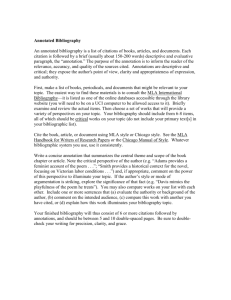

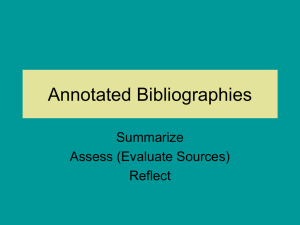

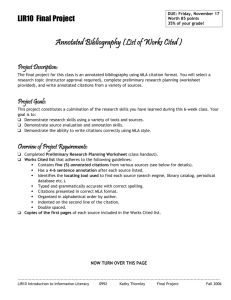
![ENC 1102 Hybrid Day 24‹Parts of an Annotated Bibliography [M 4-9]](http://s3.studylib.net/store/data/006813293_1-f9df0b3a4fca2bb83cd912cb9db27c26-300x300.png)
